Letter from gen Z: TikTok has a fast fashion problem
TikTok is revving up the speed of fast fashion, which is in turn increasing the load on landfills. Brands can play a key role in changing the status quo and gen Z consumers are demanding it. Here’s what marketers need to do.

TikTok has become a major force in driving new fashion trends / Adobe Stock
Shopping is more accessible than ever; all it takes is a touch of the finger. And social media apps, specifically TikTok, have encouraged shoppers to keep spending their money. With over 1 billion users as of September 2021 (according to data from Hootsuite), TikTok is reaching vast sums of people all over the world. Influencers often advertise – sometimes, but not always, through a paid partnership – specific clothing products to their followers.
TikTokers, such as @wisdm8 (8 million followers) and @the.navarose (5.7 million followers), have become the new face of fashion. They could even be considered social media’s role models when it comes to style. Their videos are clearly working: 39% of gen Zers are directly influenced to purchase an item after seeing it on TikTok, per Marketing Charts. Many buyers no longer look at stores and magazines to figure out what to wear – they look to their phones. And who can blame them? Online shopping makes our lives easier, in part by eliminating the hassle of going to an outdated mall.
As social media makes it easier to expand your wardrobe, it’s also speeding up the life cycle of fashion trends. TikTok especially causes trends to constantly change, as influencers post about new items every day. This results in a continuous buying cycle – who doesn’t want to have the newest, most stylish thing? But that also introduces a problem: as buyers constantly pursue the next best thing, they’re simultaneously leaving last week’s trends in the dust. They’re unable to stick to one type of style – one day it’s Y2K with Juicy Couture tracksuits, the next it’s the 70s with bell bottom jeans. Since we’re endlessly absorbing fashion through social media, I can’t help but wonder if our generation will actually have a signature style.
An inability to commit to just one type of fashion doesn’t only hurt pockets – it’s also detrimental to the environment. In 2018, a staggering 11.3m tons of textiles ended up in landfills, according to the Environmental Protection Agency. Clothing products rarely last. More often, they die out after a few months and end up in the waste. A green knitted dress with water print swirls from the UK shop House of Sunny gained mass popularity on TikTok during the beginning of summer 2021, but was soon considered to be uncool. One can imagine that it ended up with the other millions of tons rotting in a dump and polluting our planet.
TikTok is making fast fashion faster
What can clothing companies do to lessen the impact of this growing problem? For one thing, they should look to the origin of the problem: social media. Many influencers take on a side hustle by sharing their used clothing via online secondhand marketplaces, such as Poshmark and Depop. Companies could potentially partner with these apps in order to sell previously owned clothing from their brand at a discounted price. This would reduce the amount of new clothing being produced and could prevent unwanted clothing from being thrown out. In addition to helping the environment, that could also save companies money on production costs. And where would brands advertise this new collaboration? TikTok, of course.
Brands could also take in used clothes and either donate or reuse them; H&M is currently doing this with its Garment Collecting program. They could also possibly integrate secondhand clothing into new items if they could find a way to reuse the fabric. Could a shirt be refashioned as a skirt? Jeans into a bag?
Clothing companies should take responsibility for the environmental impacts of their industry. And though TikTok is currently driving the problem of trend-hopping, it can also be a solution – if brands commit to slowing down the speed of fast fashion.
Sofia Baracskai is a senior at Notre Dame School in Manhattan. She aspires to graduate from college with a degree in marketing.
